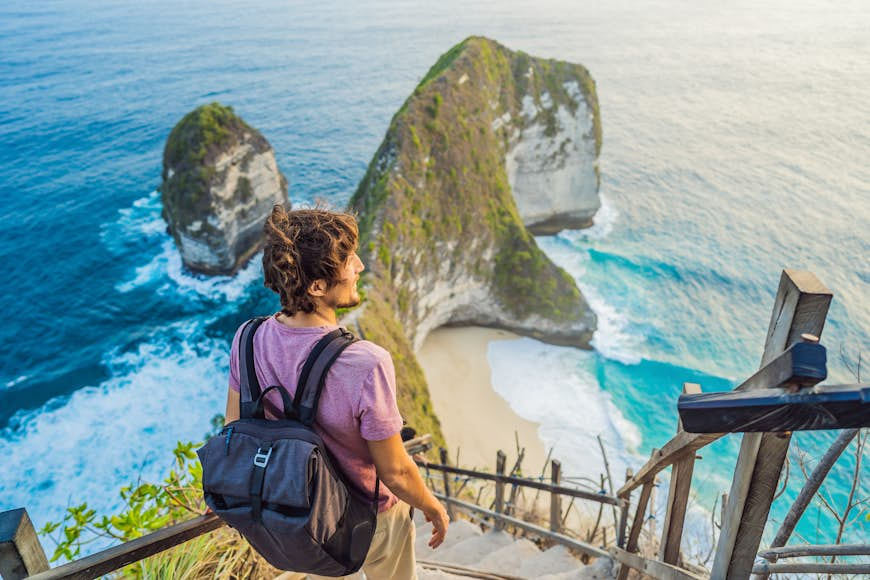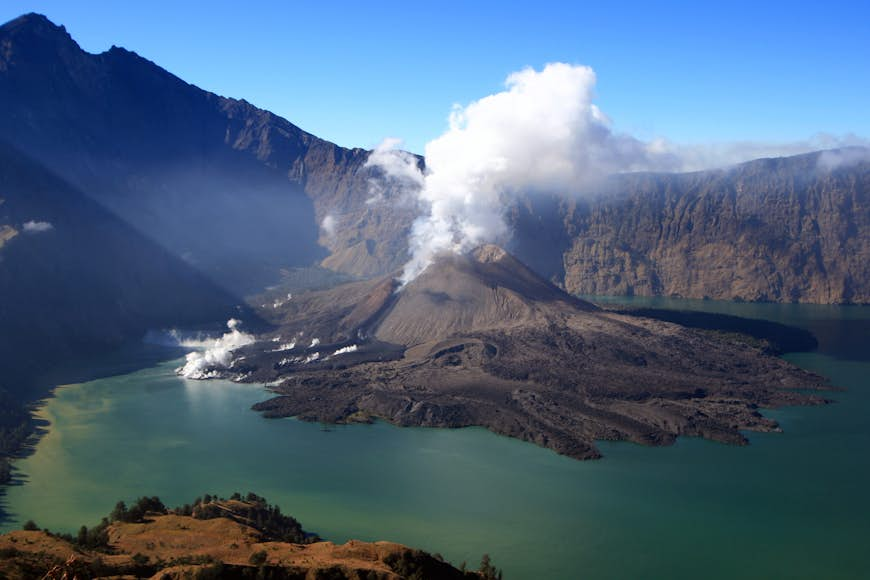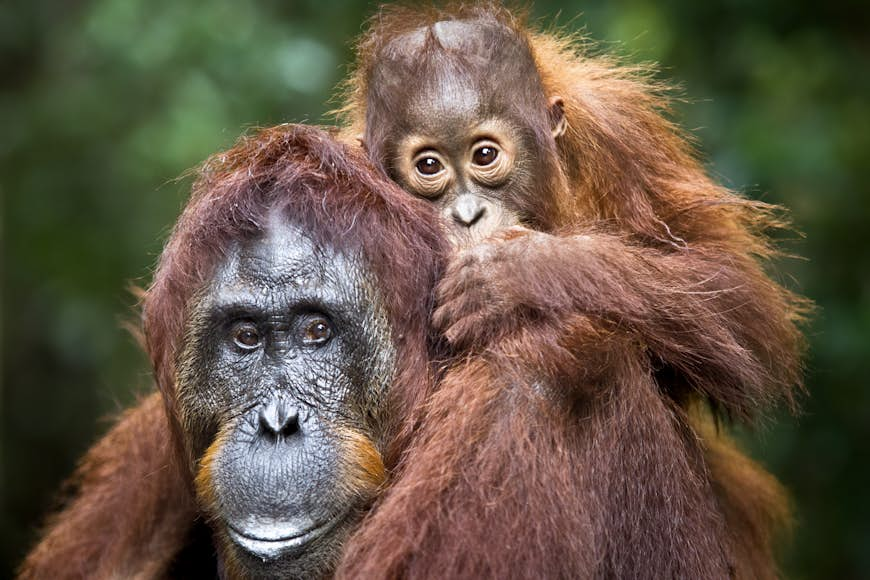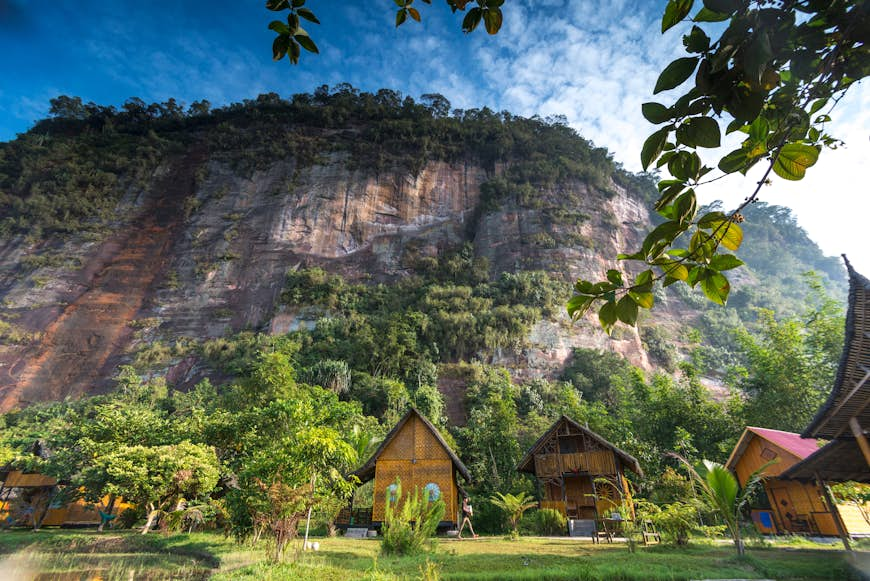Published: Lonely Planet, Apr 2022
As the largest archipelagic country in the world, majestic Indonesia showcases a wealth of jaw-dropping natural wonders across its 17,000-or-so islands. From leviathan volcanoes and lakes that hang uniquely above the sea to pristine sweeps of white sand and rivers that wind through rainforest like shoelaces, its agrestal beauty is seemingly endless. Here are the best natural wonders in Indonesia.
Snorkel spectacular Palau Menjangan (Deer Island), Bali
Located just off Bali’s northwestern tip, Pulau Menjangan (Deer Island) is one of Indonesia’s most accessible locations for experienced divers and adventurous snorkeling fans. The surrounding Bali Barat National Park protects twelve different dive sites, and the crystalline waters showcase sheer walls, caves, and a spectacular drop-off. Expansive corals and shapeshifting schools of tropical fish create an underwater ambiance akin to swimming in a giant aquarium – a marine spectacle achievable even by relatively novice snorkelers. For experienced divers, the fascinating 19th-century wreck of the Anker lies at a challenging depth of around 50m.
See the world’s largest volcanic lake on Sumatra
Stretching for 100km Lake Toba, the world’s largest volcanic lake, looks more like a sea. Formed 75,000 years ago following a series of colossal eruptions, the best way to take in the full glory of this Sumatran crater lake is by boat. The water itself is swimmable, with several thundering waterfalls dotted around the lake, adding some drama to the idyllic scenery.
Stay in sleepy Pulau Samosir, where you can hire a bicycle or motorbike and ride around the shoreline. The roads are very quiet, giving you plenty of time to gawp at the mountain ridges, trail the plunging green valleys, and look out for the massive Christ statues that peer from the forests here. Home to the Batak Toba people, their culture includes traditional wood carving and tribal ikat (woven cloth).

Test your vertigo at Kelingking Beach, Nusa Penida, Bali
Located on the island of Nusa Penida, a half-hour boat ride from Sanur, is one of the world’s most stunning stretches of sand. Accessible via a dramatic high cliff position where you look out over a stunning sweeping peninsula. A thin land bridge creates a surreal sight, but don’t cross it or get too close to it. After viewing the beach, which looks relatively small from the high point, you will be pleasantly surprised when you go down to the beach to find a long 80-metre stretch of pure white sand which meets the rich turquoise blue waters. Manta ray and dolphin sightings are common, and hundreds of darting swallows inhabit the caves.
Marvel at the giant lizards of Komodo National Park in the Lesser Sunda Islands
Sunbaked and barren, Komodo stands apart from other more verdant Indonesian islands, and the island’s most celebrated species is also singular and surprising. The world’s biggest lizard can grow up to three metres long, and Komodo dragons are often seen lumbering along the beach by visitors arriving at the national park’s main camp at Loh Liang.
Guided walks with national park staff continue for 30 minutes to a dry riverbed at nearby Banu Nggulung, where huge monitor lizards are often seen. Two-day/one-night boat trips to Komodo depart from raffish Labuan Bajo on nearby Flores, and day trips to Rinca—where the dragons also roam—are possible from the harbor town.
Take a 4WD to the smoldering Mt Bromo, East Java
In a country studded with volcanoes, the surreal beauty and immense scale of Java‘s Mt Bromo is one of Indonesia’s most epic natural spectacles. A vast crater – 10km across and created by the violent volcanic history of the ancient Tengger caldera – is punctuated by the oft-smoldering peak of Bromo. Immense plains of ash and volcanic sand extend to the crater’s towering cliffs, and the nearby peaks of Kursi and Batok stand as sinister companions to Bromo’s bulk. Sunrise is when the horizon-filling crater is seen at its best, and 4WD excursions leave from the nearby town of Cemoro Lawang at around 3:30 am to capture a terracotta landscape infused with the bronzed half-light of a Javanese dawn.

Climb the caldera at Gunung Rinjani, Lombok
The panoramic views from Indonesia’s second-highest volcano, which rises to 3726m, delight even the most adventurous hiker. The sight of the six km-wide silky-blue crater lake cradled by a vast caldera makes the climb worth every minute of the celebrated slog to the top. Majesty and mystic are honoured by Hindus from all over Indonesia, who make pilgrimages to join the local Lombok Sasak people and climb to the lake and the summit, bestowing offerings for the gods and spirits. It’s a tough three-day climb and a somewhat arduous hike for anyone of medium fitness. It is one of the significant volcano climbs in Indonesia.
See the changing colors of Kelimutu Lake, Flores
Best discovered at sunrise after a meandering minibus journey from nearby Moni, three intensely colored volcanic lakes sit atop the summit of Kelimutu on the eastern island of Flores. Two of the exceptionally deep crater lakes regularly change color – driven by the continuous leaching of different minerals – and the indigo smudge of a Flores dawn illuminates contrasting hues ranging from brown and orange through to black and red. All the while, Kelimutu’s third lake is daubed an iridescent shade of turquoise, glowing through the half-light, slowly revealing Kelimutu’s sparse lunar landscape.

Get up close with orangutans at Tanjung Puting National Park, Central Kalimantan
Wildlife watching and river adventures combine in this massive 4150 sq km park in central Kalimantan, the Indonesian southern part of Borneo. Rustic but comfortable riverboats travel up the Sungai Sekoneyer, stopping at orangutan feeding stations for three days to Camp Leakey, a rehabilitation center where orphaned and formerly captive orangutans are trained to live in the wild. Stellar birdlife – including darting kingfishers and regal hornbills – is often revealed along the river banks, and local operators, including Borneo Orangutan Adventure Tour, can arrange private trips on the Sekonyer’s signature two-story teak houseboats dubbed klotok.
Cruise the jungle-clad atolls of the Raja Ampat Islands, West Papua
From the comfort of a boat, spy the aquamarine waters of Bird’s Head Peninsula in West Papua as it casts its spell over the famed diving spots of Raja Ampat Islands. Located at the very northeast of the Indonesian archipelago, not far from Sorong on New Guinea, this chain of some 1500 islands – known as the Four Kings – is home to 1600 types of coral fish as well as 540 kinds of coral, plus whale sharks, turtles galore, and plenty of tiny pygmy seahorses.
A cruise past the jungle-cloaked atolls should stop at Misool Island to see 4000-year-old rock art and caves. The trails that cut across Waigeo Island are home to several colorful birds of paradise.
Tackle the Elite Trekking at Puncak Jaya (Carstensz Pyramid), West Papua
Snow in Indonesia? Well, yes. The Puncak Jaya (Carstensz Pyramid), a mountain in New Guinea, is one of the country’s crowning jewels. Rugged, remote, and quite high (4884m), trekking here is for serious mountain climbers only. It’s also bankruptingly expensive to visit – trips cost around US$17,000. But what about this for a natural wonder: a few hundred meters from the peak, Lake Idenberg is known to disappear into itself. It drains and refills itself, with black swans somehow appearing on its surface.

Join rock-climbers in the Harau Valley, West Sumatra
Easily reached from the Sumatran mountain town of Bukittinggi, the Harau Valley is fringed by soaring limestone cliffs up to 100m high and enlivened by the Lemba Harau waterfalls. Rock climbers negotiate careful routes up the cliffs while walking trails meander through emerald-green rice paddies to the valley’s quicksilver cascades. Comfortable homestay accommodation in the architectural style of West Sumatra’s Minangkabau people sits amid cooling lotus ponds.
Snorkel with stingless jellyfish in East Kalimantan
Evolved over time to become stingless, it’s possible to swim with the millions of jellyfish of Kakaban Lake in East Kalimantan, a large land-locked body of water on a coral atoll in the Derawan Archipelago. Without any natural predators, these gentle, toe-tickling, wobbly sea creatures are numerous and harmless. It’s an easy day trip from the nearby Derawan Island, where you can bed down in a homestay-style small hotel perched on stilts over the water for around US$30 a night.
Inhale the spiced air of Banda Api, Banda Islands
The Banda islands are famous for the historic spice trade when the Portuguese, Dutch, and British killed, conquered, and warred over control of the nutmeg and spice trade, dating back to the 1500s. Banda Neira is a beautiful historic township with restored forts, cannons everywhere, and fascinating ruins to visit. Climbing Banda Api is well worth it, and the boat crossing is only five minutes from the Banda Neira jetty. It’s two hours up to the summit. You see old lava flows on the way and can peek into old craters. From the top (elevation 666m), you look out over Pulau Run and Pulau Ai. Take a deep breath – you are in the heart of fragrant nutmeg and clove country, surrounded by a turquoise sea.
Stephanie Brookes is a travel writer and blogger with tales from Indonesia and beyond.
Published: Lonely Planet, April, 2022
www.travelwriter.ws
http://www.facebook.com/stephtravelwriter
www.instagram.com/stephtravelwriter
Author –“Indonesia’s Hidden Heritage; Cultural Journeys of Discovery”

